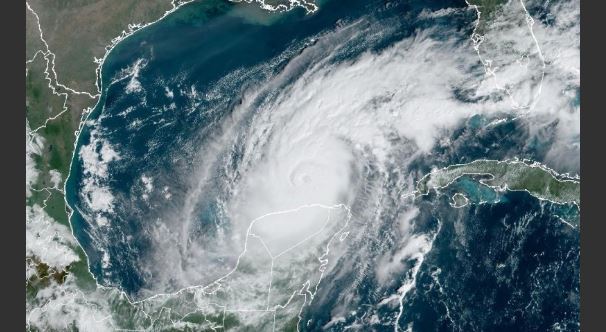Oct. 8 (UPI) — Hurricane Milton was still a powerful Category 4 storm Tuesday afternoon as it remained on track to make landfall on Florida’s western coast by Wednesday night.
In its 1 p.m. CDT Tuesday update, the National Hurricane Center said Milton was located 125 miles northeast of Progreso, Mexico, and 520 miles southwest of Tampa, Fla. It was carrying maximum sustained winds of 155 mph and moving east-northeast at 8 mph.
A hurricane warning was in effect for Celestun to Rio Lagartos, Florida’s western coast from Bonita Beach northward to the mouth of the Suwanee River, including Tampa Bay, Florida east coast from the Indian River/St. Lucie County Line northward to Ponte Vedre Beach.
A hurricane watch was in effect for Rio Lagartos to Cabo Catoche, Dry Tortugas, Lake Okeechobee, Florida’s western coast from Chokoloskee to south of Bonita Beach, Florida’s east coast north of Ponte Vedra Beach to the mouth of the St. Mary’s River.
A tropical storm warning was in effect for Rio Lagartos to Cancun; all of the Florida Keys, including Dry Tortugas and Florida Bay; Lake Okechobee; Florida’s west coast from Flamigo to south of Bonita Beach; Florida’s west coast from north of the mouth of the Suwanee River to Indian Pass; Florida’s east coast north of Ponte Vedre Bach to the mouth of the St. Mary’s River.
A tropical storm watch was in effect for the coast of Georgia and South Carolina from north of the mouth of the St. Mary’s River to South Santee River, S.C., and extreme northwetern Bahamas, including Grand Bahama Island, the Abacos and Bimini.
A storm surge watch was in effect for south of Port Canaveral to Sebastion Inlet and the mouth of the St. Mary’s River to Edisto Beach.
A storm surge warning was in effect for the west coast of Florida from Flamingo northward to the Suwanee River, including Charlotte Harbor and Tampa Bay and the east coast of Florida from Port Canaveral northward to the mouth of the St Mary’s River, including the St. John’s River.
Earlier Monday, Milton’s wind speeds had increased by 90 mph in less than 24 hours to 180 mph. It’s being called the third-fastest rapidly intensifying storm on record in the Atlantic, according to more than 40 years of National Hurricane Center data.

Central atmospheric pressure in Milton’s eye had also fallen to 897 millibars (or 26.49 inches of mercury), according to Hurricane Hunter aircraft observations, which makes it the fifth lowest central pressure in the Atlantic basin hurricane recorded history.
“This makes Milton one of the strongest hurricanes on record in the Atlantic Basin and the second strongest in the Gulf only behind Hurricane Rita in 2005 (895mb),” meteorologist Dylan Federico of Dallas’ KDFW-TV wrote in a Facebook post.
“The center of Milton is forecast to move just north of the Yucatan Peninsula today and approach the west coast of the Florida Peninsula on Wednesday,” the NHC said. “The hurricane will likely make landfall in Florida Wednesday night.”
Forecasters said the storm’s intensity will fluctuate but it is expected to remain an extremely dangerous, possibly deadly Category 3 or 4 storm when it passes over the Florida Peninsula. It is expected to remain a Category 1 storm as it exits eastward into the Atlantic.
“We urge drivers to drive safely and expect extended delays,” the sheriff’s office said.
Forecasters predicted late Monday Tampa Bay could see a surge of between 10 and 15 feet.
“On the forecast track, the center of Milton is forecast to move near or just north of the Yucatan Peninsula tonight and Tuesday, then cross the eastern Gulf of Mexico and approach the west coast of the Florida Peninsula on Wednesday,” the NHC said Monday.
While forecasters say it is too soon to specify the exact strength of the storm at landfall, or pinpoint its exact landfall location, the NHC warned of “an increasing risk of life-threatening storm surge and damaging winds for portions of the west coast of Florida,” beginning early Wednesday, with heavy rainfall to start Monday.
Portions of the Florida Peninsula and the Keys are to receive between 5 and 10 inches of rain, with some areas to receive up to 15 inches through Wednesday night, raising the risk of “considerable flash, urban and areal flooding,” the NHC said.
Meanwhile, Florida’s west coast has already been hit by two hurricanes this season.
Hurricane Helene hit the coast near Perry in the Big Bend Region on Sept. 26 as a Category 4 storm.
Hurricane Debby hit nearby Steinhatchee as a Category 1 storm on Aug. 5.
Milton, the 13th named storm of the Atlantic hurricane season, is one of three churning in the Atlantic, but is the only posing a threat to land. The other two are: Kirk, a Category 3 storm; and Leslie, which became a hurricane late Friday.





